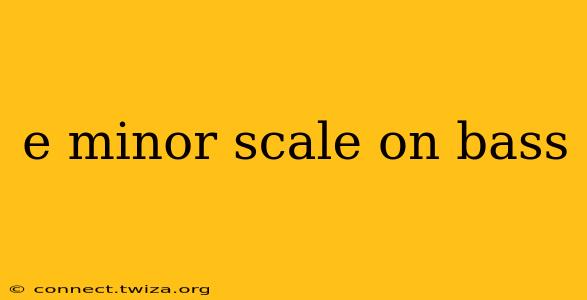The E minor scale is a cornerstone of music theory, finding its place in countless songs across various genres. For bassists, mastering this scale unlocks a world of melodic and harmonic possibilities. This guide will delve into the E minor scale's construction, variations, and practical applications, answering common questions bassists have.
What are the notes in the E minor scale?
The E minor natural scale consists of the following notes: E – F# – G – A – B – C – D – E. It's a relative minor scale to G major, meaning they share the same key signature (one sharp). Understanding this relationship helps you quickly derive the scale from a major scale you already know.
How do I play the E minor scale on the bass?
There isn't one single "right" way to play the E minor scale on bass; it depends on your desired voicing and the context of the music. However, here are a few common approaches:
- Root Position: Starting on the root note (E) is the most straightforward approach. You can ascend and descend the scale using adjacent frets.
- Pentatonic Approach: Isolating the E minor pentatonic scale (E – G – A – B – D) simplifies things, especially for beginners, offering a strong melodic foundation.
- Arpeggiated Forms: Breaking the scale into arpeggios (E – G – B – D) adds a more rhythmic and harmonic feel.
- Chromatic Approach: Incorporating chromatic notes can add color and complexity, often leading to interesting passing tones.
What are the different types of E minor scales?
Beyond the natural minor scale, several other E minor variations exist:
- E Harmonic Minor: This scale alters the 7th degree, raising it a half-step to C#. This creates a characteristic leading tone that pulls strongly towards the tonic (E). The notes are: E – F# – G – A – B – C# – D – E.
- E Melodic Minor: This scale raises both the 6th and 7th degrees (C and D respectively). Ascending, the notes are: E – F# – G – A – B – C# – D# – E. Descending, it typically reverts to the natural minor scale.
Each variation lends a distinct flavor to the music, and experimenting with these will greatly expand your musical vocabulary.
What are some common E minor chord progressions?
The E minor scale naturally leads to various chord progressions. Common ones include:
- Em – Am – C – G: A classic progression found in numerous genres.
- Em – C – G – D: A simpler, more straightforward progression.
- Em – Am – Bm – C: A progression with a slightly darker feel.
Experimenting with these and creating your own progressions will help you develop your improvisational skills.
How can I practice the E minor scale effectively?
Effective practice involves more than just rote repetition. Try incorporating these techniques:
- Scales in different octaves: Practice ascending and descending the scale across different registers of the bass.
- Rhythmic variations: Play the scale with different rhythmic patterns, such as triplets, eighth notes, and dotted rhythms.
- Slurs and legato: Practice smooth transitions between notes using legato techniques.
- Improvisation: Improvise over backing tracks in E minor to develop your musical phrasing and creativity.
Mastering the E minor scale on bass is a journey, not a destination. Consistent, focused practice using these techniques will dramatically improve your bass playing and musicality. Remember to listen to music in E minor to internalize the sound and feel of the scale within various musical contexts. This will help you develop your ear and improve your overall understanding of music theory.
